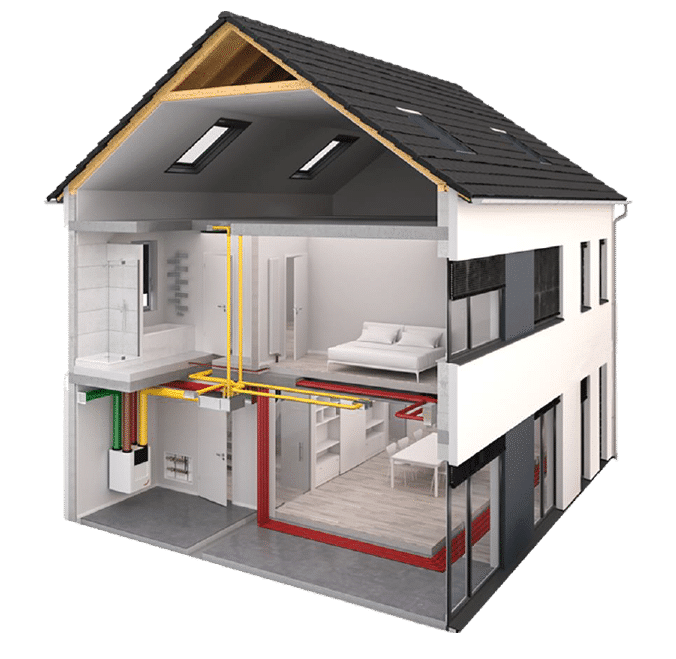Exploring HRV: A Step-by-Step Introduction
Wiki Article
The All-Inclusive Overview to the Uses of Heat Recovery Ventilation in Modern Structures
Heat Recovery Ventilation (HRV) systems stand for a significant innovation in developing innovation (HRV Heat Recovery Ventilation). They give a technique for trading stagnant interior air with fresh outdoor air while decreasing power loss. This approach not only boosts interior air top quality yet also adds to energy effectiveness in both household and industrial structures. Recognizing the different applications and benefits of HRV can reveal its important duty in modern-day layout and sustainability efforts. The effects of this innovation are worth exploring even moreUnderstanding Heat Recovery Ventilation Systems

Although several contemporary structures prioritize power performance, understanding warmth recuperation ventilation (HRV) systems is vital for enhancing interior air top quality and reducing power intake. HRV systems function by transferring heat from stagnant interior air to inbound fresh air, successfully preserving comfortable indoor temperature levels while decreasing power loss. These systems include a warmth exchanger, followers, and ductwork that promote the flow of air. During winter, HRV units catch and recycle warmth from the outward bound air, while in summer season, they can aid cool down incoming air. By constantly trading air, HRV systems likewise decrease moisture and the focus of indoor toxins. Proper installment and upkeep of HRV systems are essential for their efficiency and performance in improving overall building efficiency and comfort.
Advantages of Heat Recovery Ventilation
Heat recovery ventilation systems provide various benefits that enhance both power efficiency and indoor air high quality in modern-day structures. By recording and reusing energy from exhaust air, these systems considerably minimize home heating and cooling prices, causing reduced energy intake. They keep a steady flow of fresh exterior air, minimizing the risk of indoor air pollutants and irritants. This continual exchange assists control humidity levels, protecting against mold growth and making sure a much healthier living environment. In addition, HRV systems contribute to sustainability objectives by decreasing total carbon footprints. Their capacity to maximize ventilation without sacrificing thermal comfort makes them a beneficial addition to modern building style, advertising both economic and ecological advantages.Applications of HRV in Residential Buildings
As home owners significantly prioritize energy efficiency and indoor air high quality, the applications of warm recuperation ventilation (HRV) systems in property structures have actually become more common. HRV systems are specifically useful in tightly sealed homes, where keeping fresh air blood circulation is necessary for preventing dampness build-up and interior toxins. They successfully transfer warmth from outgoing stagnant air to inbound fresh air, lowering power costs related to cooling and heating. In addition, HRVs can improve comfort degrees by regulating humidity and temperature level. They are also adaptable for numerous domestic styles, consisting of single-family homes and multi-unit buildings. On the whole, incorporating HRV systems sustains sustainable living methods read more while ensuring click a much healthier interior environment for residents.HRV in Industrial and Commercial Setups
In commercial and commercial setups, the implementation of warm healing ventilation (HRV) systems has actually ended up being increasingly vital for optimizing energy efficiency and preserving air quality. These systems successfully transfer warmth from exhaust air to inbound fresh air, minimizing the need for added heating or cooling. This not only decreases energy expenses yet also adds to sustainability initiatives. Industries such as production, warehousing, and office complex benefit significantly from HRV systems, as they assist regulate temperature and humidity degrees, guaranteeing a comfortable and productive environment. Additionally, HRV systems aid in removing pollutants and excess wetness, improving indoor air top quality. As regulations around air quality come to be stricter, the adoption of HRV modern technology is most likely to expand, making it a crucial component of modern-day industrial and commercial framework.Future Fads in Heat Recovery Ventilation Modern Technology

Regularly Asked Questions
Just How Does Heat Recovery Ventilation Impact Indoor Air Quality?
Heat recovery ventilation greatly boosts indoor air top quality by constantly exchanging stale indoor air with fresh outdoor air while recovering energy. This process minimizes pollutants, preserves ideal humidity degrees, and guarantees a much healthier setting for owners.Can HRV Equipments Be Installed in Existing Buildings?
HRV systems can undoubtedly be set up in existing structures. Retrofitting might require alterations to ductwork and air flow formats, but it substantially enhances power efficiency and indoor air top quality, making it a sensible choice for older structures.What Maintenance Is Needed for HRV Systems?

Are There Certain Climates Where HRV Is More Efficient?
Heat recovery ventilation systems are specifically reliable in environments with significant temperature level differences between seasons. These systems optimize energy efficiency by recuperating warm from exhaust air, making them ideal for both cool and moderately warm settings.Exactly How Do HRV Solutions Affect Power Expenses?

Report this wiki page